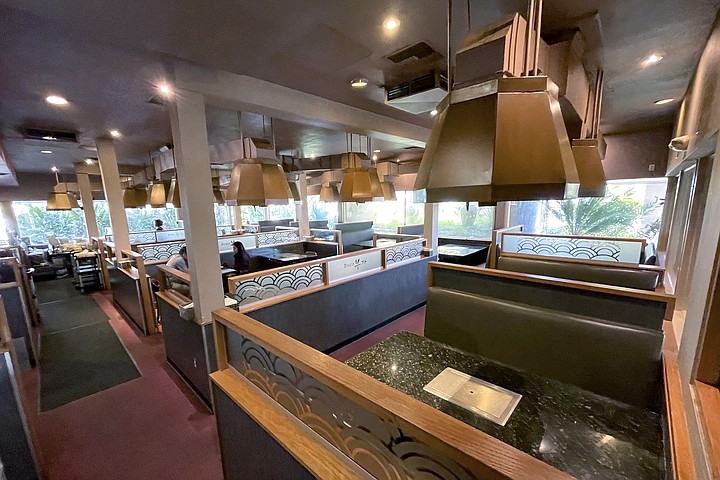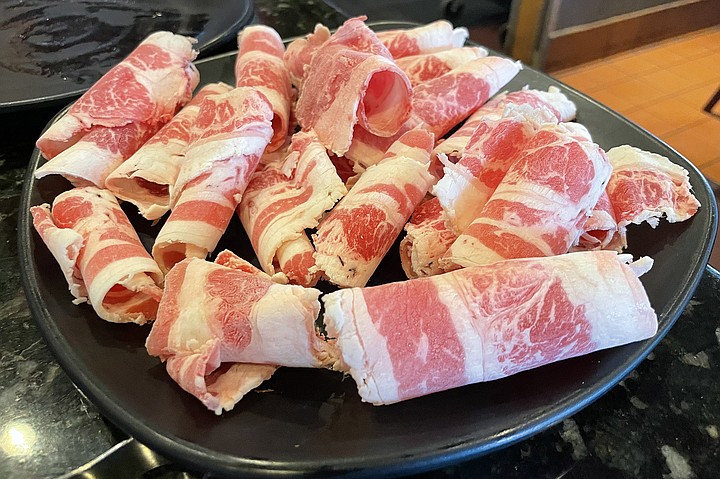 Facebook
Facebook
 X
X
 Instagram
Instagram
 TikTok
TikTok
 Youtube
Youtube

It had been well over two years since I last plied my hunger at an offer of all-you-can-eat. Back in the 2010s, friends and I would saunter into a place determined to out-eat such offers. So, if the all-you-can-eat menu cost $25, we’d strive to eat $50 worth of food (as priced on the regular menu). More often than not, we could pull it off. I was a champion, undisputed and undefeated.
Alas, my return to such gluttony did not go as planned. Apparently, two years of pandemic have left me in poor all-you-can-eat shape. In this case, the restaurant won.
Three key rules govern the three all-you-can-eat menus of Clairemont Mesa restaurant Buga Korean BBQ. First, everyone at your table must agree to the same menu. Which is fair: the $39 menu, for example, offers premium meats; the $34 and $29 menus do not, including ribeye and short fib filets. Given that Korean BBQ diners cook meats on a grill built into the center of their tables, it would otherwise be too easy for one person to pay $39, then share that ribeye with the $29 members of their party.

Once you’ve settled on a menu, the clock starts on a two-hour, all-you-can-eat window. Finally, what I like to call a leftovers clause, which limits customers to what we can, in fact, eat in a sitting. You must pay full-menu price for any dish you ask for, but can’t finish.
Knowing all this, here’s how I thought our meal at Buga would go. We’d pregame by grazing on traditional banchan (Korean appetizers including kimchi, pickled daikon, and fish cakes). Then, our first round would arrive: beef dishes, to get the best stuff out of the way while we were hungriest. Then, a second round, featuring pork, followed by a third round of chicken and vegetables. Finally, if I had room, an order of delicious soft tofu stew to fill in whatever gaps remained in my belly.

Here's what happened instead: Buga scored a first-round knockout.
Contributing to this was the deung shim, that whole ribeye filet from the $39 menu. However, it’s only six ounces, cut thin to sear quickly atop the in-table grill. Meanwhile, the fine print points out you only get one ribeye per two guests. Likewise, the kout sal ribeye filets are limited to a few ounces per two customers. Two of us could handle each without issue, paired with dukbossam, post-it sized strips of rice noodle you can use to wrap up small morsels of meat coming hot off the grill. I enjoyed this with bite-sized portions of the steak, which our server sliced up for us with a pair of scissors.

We even could have handled the large plate of beef belly, shaved into wide, bacon-like ribbons of meat and fat that shrivel into delectable wisps, perfect to serve over a bowl of rice.
What did us in was Buga’s prized, marinated short rib dish, jumuluk. Unlike the ribeye or kout sal, there is no limit on this premium meat (featured on both the $34 and $39 menus). Priced at $45 on the regular menu, our server kindly ordered a double portion when we asked for it. I take it she was doing us a favor.
Except, from the all-you-can-eater’s perspective, it looked like a mountain of beef — at least a pound — and it turned out to be all I could eat. I would leave Buga too full to regret not trying any pork belly or tofu stew. But as tasty and tender as the short rib was, by the end it felt like I had been eating nothing but jumuluk for an hour, mostly to make sure I didn’t trigger that no leftovers clause.
Belatedly, I learned you can request single, or even half-portions, of each all-you-can-eat item, which would have made it easier to spread things around and try a little bit of everything. I will definitely apply that lesson to my next Buga bout. But first, I’m going to need a few months of training, so I can show up ready to fight.


It had been well over two years since I last plied my hunger at an offer of all-you-can-eat. Back in the 2010s, friends and I would saunter into a place determined to out-eat such offers. So, if the all-you-can-eat menu cost $25, we’d strive to eat $50 worth of food (as priced on the regular menu). More often than not, we could pull it off. I was a champion, undisputed and undefeated.
Alas, my return to such gluttony did not go as planned. Apparently, two years of pandemic have left me in poor all-you-can-eat shape. In this case, the restaurant won.
Three key rules govern the three all-you-can-eat menus of Clairemont Mesa restaurant Buga Korean BBQ. First, everyone at your table must agree to the same menu. Which is fair: the $39 menu, for example, offers premium meats; the $34 and $29 menus do not, including ribeye and short fib filets. Given that Korean BBQ diners cook meats on a grill built into the center of their tables, it would otherwise be too easy for one person to pay $39, then share that ribeye with the $29 members of their party.

Once you’ve settled on a menu, the clock starts on a two-hour, all-you-can-eat window. Finally, what I like to call a leftovers clause, which limits customers to what we can, in fact, eat in a sitting. You must pay full-menu price for any dish you ask for, but can’t finish.
Knowing all this, here’s how I thought our meal at Buga would go. We’d pregame by grazing on traditional banchan (Korean appetizers including kimchi, pickled daikon, and fish cakes). Then, our first round would arrive: beef dishes, to get the best stuff out of the way while we were hungriest. Then, a second round, featuring pork, followed by a third round of chicken and vegetables. Finally, if I had room, an order of delicious soft tofu stew to fill in whatever gaps remained in my belly.

Here's what happened instead: Buga scored a first-round knockout.
Contributing to this was the deung shim, that whole ribeye filet from the $39 menu. However, it’s only six ounces, cut thin to sear quickly atop the in-table grill. Meanwhile, the fine print points out you only get one ribeye per two guests. Likewise, the kout sal ribeye filets are limited to a few ounces per two customers. Two of us could handle each without issue, paired with dukbossam, post-it sized strips of rice noodle you can use to wrap up small morsels of meat coming hot off the grill. I enjoyed this with bite-sized portions of the steak, which our server sliced up for us with a pair of scissors.

We even could have handled the large plate of beef belly, shaved into wide, bacon-like ribbons of meat and fat that shrivel into delectable wisps, perfect to serve over a bowl of rice.
What did us in was Buga’s prized, marinated short rib dish, jumuluk. Unlike the ribeye or kout sal, there is no limit on this premium meat (featured on both the $34 and $39 menus). Priced at $45 on the regular menu, our server kindly ordered a double portion when we asked for it. I take it she was doing us a favor.
Except, from the all-you-can-eater’s perspective, it looked like a mountain of beef — at least a pound — and it turned out to be all I could eat. I would leave Buga too full to regret not trying any pork belly or tofu stew. But as tasty and tender as the short rib was, by the end it felt like I had been eating nothing but jumuluk for an hour, mostly to make sure I didn’t trigger that no leftovers clause.
Belatedly, I learned you can request single, or even half-portions, of each all-you-can-eat item, which would have made it easier to spread things around and try a little bit of everything. I will definitely apply that lesson to my next Buga bout. But first, I’m going to need a few months of training, so I can show up ready to fight.
Comments